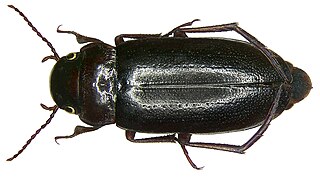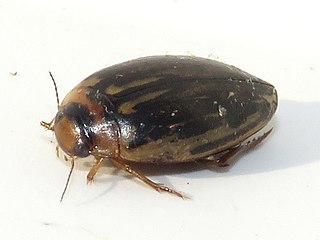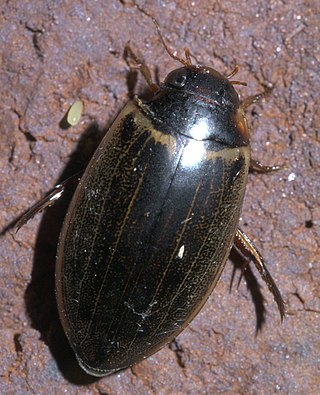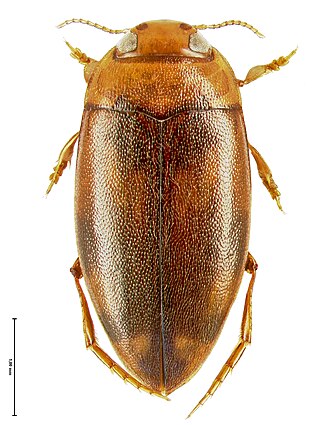
The Dytiscidae – based on the Greek dytikos (δυτικός), "able to dive" – are the predaceous diving beetles, a family of water beetles. They occur in virtually any freshwater habitat around the world, but a few species live among leaf litter. The adults of most are between 1 and 2.5 cm (0.4–1.0 in) long, though much variation is seen between species. The European Dytiscus latissimus and Brazilian Megadytes ducalis are the largest, reaching up to 4.5 cm (1.8 in) and 4.75 cm (1.9 in) respectively. In contrast, the smallest is likely the Australian Limbodessus atypicali of subterranean waters, which only is about 0.9 mm (0.035 in) long. Most are dark brown, blackish, or dark olive in color with golden highlights in some subfamilies. The larvae are commonly known as water tigers due to their voracious appetite. They have short, but sharp mandibles and immediately upon biting, they deliver digestive enzymes into prey to suck their liquefied remains. The family includes more than 4,000 described species in numerous genera.

Megadytes is a genus of diving beetles in the family Dytiscidae. They are found in slow-moving or static freshwater habitats throughout most of the Neotropics, ranging from Florida and Mexico, through the West Indies and Central America, to South America as far south as central Argentina. The adult beetles measure about 1.65–4.75 cm (0.6–1.9 in) long depending on the exact species and the largest is also the largest in the family.
Carabdytes alutaceus is an endangered species of beetle in the family Dytiscidae. It is endemic to New Caledonia, in the southwest Pacific Ocean.

Rhantus is a genus of beetle in family Dytiscidae. There are about 100 species distributed worldwide. They often live in pools and marshy habitat types. Several species have colonized oceanic islands and become endemics.
Meridiorhantus orbignyi is an extinct species of predaceous diving beetle in the family Dytiscidae. This species was formerly a member of the genus Rhantus.

Carabdytes is a genus of predaceous diving beetles in the family Dytiscidae. Carabdytes upin was formerly the sole species of this genus, but nine species in the genus Rhantus were transferred to Carabdytes as a result of research published by Balke et al. in 2017.

Coptotomus is a genus of predaceous diving beetles in the family Dytiscidae, the only genus of the subfamily Coptotominae. There are about six described species in Coptotomus, found in North America and the Neotropics.
Exocelina subjecta is a species of diving beetle in the genus Exocelina of the subfamily Copelatinae in the family Dytiscidae, described by David Sharp in 1882.

Meridiorhantus calidus is a species of predaceous diving beetle in the family Dytiscidae. It is found in North America and the Neotropics. This species was formerly a member of the genus Rhantus.
Carabdytes plantaris is a naturally uncommon species of diving beetle in the family Dytiscidae. It is endemic to New Zealand. For over a century, it was known from just a single specimen collected in 1880 "near Dunedin", and doubts were cast on whether it was actually a New Zealand species at all. In 1986, it was rediscovered when several were collected from a roadside pond near Lake Ellesmere. Carabdytes plantaris is now classed as "naturally uncommon" by the Department of Conservation.

Nartus grapii is a species of beetle in family Dytiscidae, found in the Palearctic. This species was formerly a member of the genus Rhantus.
Nartus sinuatus Black with dark rufous legs; posterior margin of pronotum arched just before hind angles(3) is a species of predaceous diving beetle in the family Dytiscidae, found in North America. This species was formerly a member of the genus Rhantus.

Colymbetini is a tribe of predaceous diving beetles in the family Dytiscidae. There are about 11 genera and more than 160 described species in Colymbetini.

Neobidessodes is a genus of predaceous diving beetles in the family Dytiscidae. There are about 10 described species in Neobidessodes. They are found in Australasia. The genus was first described in 2009, and the type species is N. denticulatus.

Meridiorhantus is a genus of predaceous diving beetles in the family Dytiscidae. There are about five described species in Meridiorhantus, found in the Neotropics and North America. These species were formerly members of the genus Rhantus, but were moved to Meridiorhantus when it was created by Balke et al. in 2017.
Caperhantus is a genus of predaceous diving beetles in the family Dytiscidae. There is one described species in Caperhantus, C. cicurius. This species was formerly a member of the genus Rhantus.

Nartus is a genus of predaceous diving beetles in the family Dytiscidae. There are at least two described species in Nartus. These species were formerly members of the genus Rhantus, but were moved to Nartus when it was reinstated by Balke et al. in 2017.
Laccophilus sharpi, is a species of predaceous diving beetle found in Asia, Africa and Australian region.

Neobidessodes grossus is a carnivorous subterranean water beetle, in the Bidessini tribe of the Dytiscidae family. It was first described in 1922 by Albrecht Zimmermann as Bidessus grossus. It was assigned to the genus Bidessodes by Watts in 1978, and to the new genus of Neobidessodes in 2009 by Hendrich and others.
Neobidessodes bilita is a carnivorous subterranean water beetle, in the Bidessini tribe of the Dytiscidae family. It was first described in 1978 by Chris H.S. Watts as Bidessodes bilita, and reassigned to the genus of Neobidessodes in 2009 by Hendrich and others.









